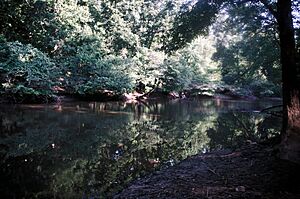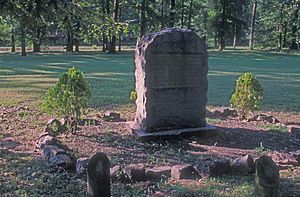Battle of Jenkins' Ferry facts for kids
Quick facts for kids Battle of Jenkins' Ferry |
|||||||
|---|---|---|---|---|---|---|---|
| Part of the Trans-Mississippi Theater of the American Civil War |
|||||||
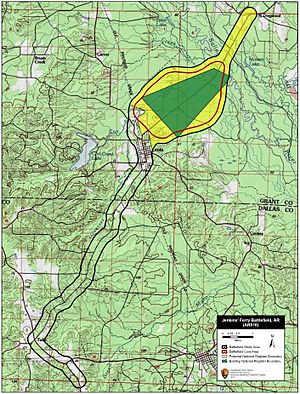 Jenkins' Ferry Battlefield |
|||||||
|
|||||||
| Belligerents | |||||||
| Commanders and leaders | |||||||
|
|
|||||||
| Units involved | |||||||
| Department of Arkansas | Army of Arkansas | ||||||
| Strength | |||||||
| 12,000 | 10,000 | ||||||
| Casualties and losses | |||||||
| 700 | 1,000 | ||||||
The Battle of Jenkins' Ferry was a key fight during the American Civil War. It happened on April 30, 1864, near Jenkins' Ferry, southwest of Little Rock, Arkansas. Even though the Union army won the battle, the Confederates saw it as a success. They believed they stopped Union General Frederick Steele from taking control of southwest Arkansas. This battle was very chaotic, so the exact number of soldiers hurt or killed is hard to know.
Jenkins' Ferry was the most important battle of Steele's Camden Expedition. This expedition was part of the larger Red River campaign. After this battle, the U.S. forces were able to escape from a dangerous spot in Camden and return safely to their defenses in Little Rock. Today, much of the battlefield is still preserved.
Contents
Why the Battle Happened
The Red River Campaign
In March 1864, the United States Army and United States Navy started a big plan called the Red River Campaign. Their main goal was to capture Shreveport, Louisiana, which was a major Confederate city. Shreveport was the headquarters for Confederate General Edmund Kirby Smith. It was also a temporary capital for Louisiana and a key supply center.
Another goal was to buy cotton, which was needed in the northern states. The Union also hoped to bring Louisiana back into the United States. The plan was also meant to stop French forces from moving into the U.S. from Mexico. France had taken over Mexico in 1863.
President Abraham Lincoln approved this plan. General Ulysses S. Grant, who was in charge of all U.S. armies, wanted the campaign to finish quickly. He preferred to use the soldiers elsewhere, like helping General William Tecumseh Sherman in his march toward Atlanta.
Union Forces Assemble
General Nathaniel P. Banks led about 20,000 Union soldiers from New Orleans. He was joined by 10,000 soldiers from General Sherman's army, led by General Andrew Jackson Smith. These troops traveled up the Red River with U.S. Navy ships. They successfully captured Fort DeRussy, opening the river.
Major-General Frederick Steele was also supposed to help. He commanded about 14,000 men from Union bases in Arkansas, like Little Rock and Fort Smith. Steele's job was to support Banks's attack on Shreveport.
Road to Jenkins' Ferry
March to Camden
Steele's part of the campaign was called the Camden Expedition. His goal was to reach and occupy Camden, Arkansas. He also wanted to draw Confederate cavalry away from Shreveport. However, General Banks expected Steele to join him in attacking Shreveport.
Steele started with 8,000 men from Little Rock. He marched southwest to Arkadelphia, Arkansas. He was supposed to meet another Union force of 4,000 men from Fort Smith, led by General John Milton Thayer. Steele was three weeks late, and when he arrived in Arkadelphia on March 29, 1864, Thayer wasn't there. Steele's men were tired and low on food.
After waiting a few days, Steele moved toward Washington, Arkansas, the temporary Confederate capital of Arkansas. He finally met Thayer on April 9, 1864, near Elkins' Ferry. But Thayer brought few supplies, so the combined force was still short on food.
Confederate cavalry, led by General Sterling Price and General John S. Marmaduke, tried to slow Steele down. They fought small battles at Elkins' Ferry and Prairie D'Ane. On April 12, Steele tricked the Confederates by pretending to go to Washington. Then, he quickly moved to Camden. Steele's forces occupied Camden on April 15, 1864. Price had already left Camden to defend Washington.
Supply Problems and Confederate Attacks

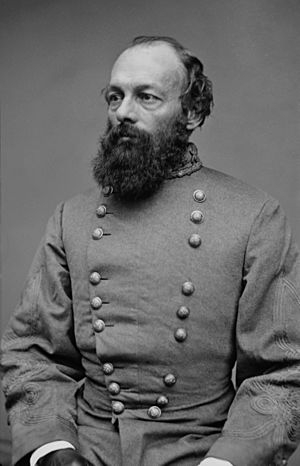
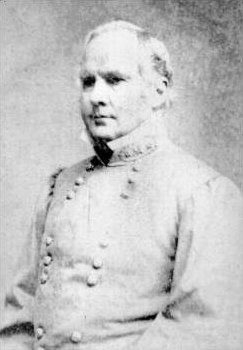
Steele hoped to get supplies from Little Rock and Pine Bluff. But Confederate cavalry, led by General Marmaduke and General Samuel B. Maxey, stopped a Union supply group. At the Battle of Poison Spring on April 18, 1864, the Confederates captured most of 170 wagons. They also killed or captured many Union soldiers. Reports said that some African-American soldiers were killed even after trying to surrender.
Around this time, Steele learned that General Banks had been defeated at the Battle of Mansfield in Louisiana. Banks was retreating. On April 23, Steele told Banks he couldn't join him. Steele now faced not only Confederate cavalry but also infantry led by General Price and General Kirby Smith. Kirby Smith decided that Steele's army was a bigger target than Banks's. He wanted to destroy Steele's force first.
On April 25, 1864, at the Battle of Marks' Mills, Confederate cavalry captured another Union supply train. This train was heading to Pine Bluff. Most of the 1,300 Union soldiers guarding it were captured or killed. Again, reports said that wounded African-American soldiers were killed by Confederates. These events would later lead to revenge by Union soldiers.
Steele's Retreat
Steele's army was now very low on supplies. They were also outnumbered and in danger of being surrounded in Camden. Steele decided to retreat back to Little Rock. His army started moving at night on April 26 and early morning on April 27, 1864.
The Confederates didn't notice Steele's escape until later. Steele's forces used a special pontoon bridge to cross the Ouachita River. This gave them a head start. The Confederates had to build their own raft bridge to cross the swollen river, which took time.
As Steele's army marched north, Confederate cavalry harassed them. When Steele's forces reached Jenkins' Ferry on the Saline River, they had to stop again. The river was swollen, and they needed to build their pontoon bridge to cross. The remaining 10,000 Confederates under Kirby Smith and Price caught up to Steele's 10,000 men. The Confederates attacked Steele's rear guard early on April 30, 1864. Steele had to fight them off while his soldiers worked to get their wagons and artillery across the river.
The Battle of Jenkins' Ferry
Steele's Union forces arrived at Jenkins' Ferry on April 29, 1864. Heavy rain had made the Saline River very high, and the ground was a muddy mess. The tired soldiers struggled to build their bridge and move wagons. Union cavalry managed to cross overnight.
Knowing the Confederates were close, a Union rear guard set up strong defenses. They built breastworks (low walls) and dug rifle pits. General Samuel Allen Rice led about 4,000 Union infantrymen in this defense. Their position was protected by a creek on one side and thick, muddy woods. The only way for the Confederates to attack was through a narrow, muddy path about 400 yards wide.
Before dawn on April 30, Confederate cavalry arrived and began fighting. General Rice's men were ready. The Confederates, led by Generals Thomas J. Churchill and Mosby Parsons, attacked in waves. But the muddy ground and strong Union defenses made it very hard for them. They attacked brigade by brigade, not all at once.
Gunpowder smoke and fog filled the air, making it hard to see. This helped the Union defenders, who could fire into the narrow attack area. The mud also stopped cavalry and artillery from being very useful. In fact, Union soldiers captured three Confederate cannons during a charge.
Later, General Kirby Smith arrived with a large Texas infantry division. These soldiers also attacked in the same way, brigade by brigade. Three of their commanders were wounded, and two of them died. Union General Samuel Rice was also badly wounded in the battle and later died.
After losing about 1,000 men, the Confederates stopped their attacks. The Union forces had lost about 700 men. Some African-American soldiers from the Union army shot Confederate wounded near their lines. This was in revenge for the killing of African-American soldiers at Poison Spring and Marks' Mill.
By 3:00 p.m. on April 30, the Union forces had finally crossed the Saline River. They had to leave some wagons stuck in the mud, which they burned. Once across, Steele's men cut and burned their pontoon bridge. This meant the Confederates couldn't follow them. The Confederates had missed their chance to destroy Steele's army. After three more days of marching, Steele's forces safely reached Little Rock.
What Happened Next
The Battle of Jenkins' Ferry was one of the bloodiest battles of the Civil War, considering the number of soldiers involved. The Confederates reported about 443 casualties (killed, wounded, missing), but the true number was likely higher, perhaps 800 to 1,000. The Union officially reported 521 casualties, but this number was also incomplete. Historians estimate around 700 Union casualties.
The Union won the battle tactically. They held back the Confederates and allowed most of their army to escape. However, it was not a strategic victory for the Union. The Confederates still controlled the battlefield and stopped Steele from joining General Banks. Steele's army had to retreat all the way back to Little Rock.
Overall, in the Camden Expedition, Steele lost about 3,000 men, while Kirby Smith lost about 2,000. Steele also lost 10 cannons, 635 wagons, and 2,500 mules. The Confederates captured many supplies.
Kirby Smith had a chance to destroy Steele's army, but his attacks at Jenkins' Ferry were not well-coordinated. The muddy conditions and strong Union defenses made it difficult. The Confederates failed to attack the Union's weaker left side early on, which allowed the Union to strengthen it.
Steele's decision to retreat from Camden was a good one. His army was in great danger. General Banks also had to give up his plan to attack Shreveport. The Red River Campaign was a big loss for the Union. They lost over 8,000 men and many supplies. The Confederates lost about 6,500.
However, the Confederates did gain a strategic victory. They delayed 10,000 Union soldiers from joining General Sherman's important Atlanta Campaign. This helped the Confederates in other parts of the war. The Union also tied up many resources in this campaign that could have been used elsewhere.
The disruption of Union forces in Arkansas also opened the way for Price's 1864 invasion of Missouri. However, that campaign also failed, and the Confederates were driven out of Missouri after the Battle of Westport.
Battlefield Today
The battlefield is now preserved as Jenkins' Ferry Battleground State Park. It is part of the Camden Expedition Sites National Historic Landmark, which protects important places from this campaign.
In Movies
The battle is briefly shown in the 2012 movie Lincoln. Fictional soldiers talk about it with President Abraham Lincoln.


